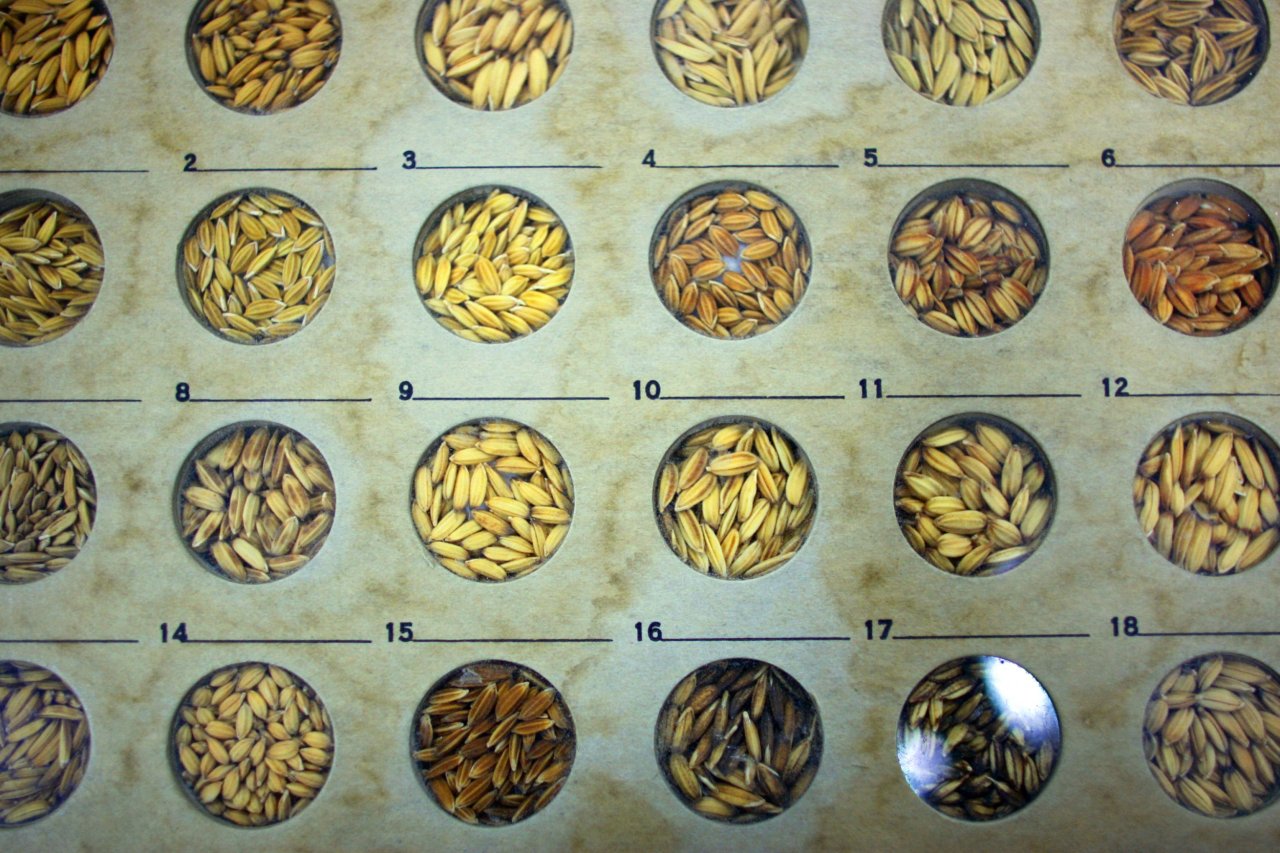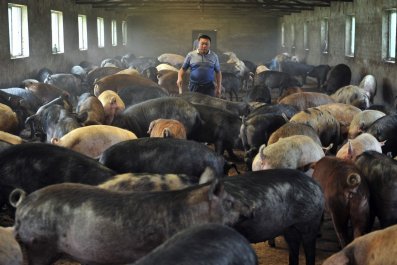"I've never had so many students want to take part in a project," says Jane Langdale. "They want to save the world."
Langdale, a professor of plant development at the University of Oxford, is part of a team of scientists from 12 universities in eight countries working to develop a new strain of hyperefficient, drought-resistant rice known as C4. And in a world with a rapidly changing climate where nearly a billion people live in hunger, it could have a huge impact.
Over 3 billion people across the globe depend on rice for survival—it's one of the most widely consumed food crops, providing over one-fifth of the calories consumed by humans worldwide. As populations grow, this demand will increase. According to the International Rice Research Institute, each hectare of land (about 2.5 acres) used to cultivate rice in Asia provides food for 27 people. But by 2050, that same hectare will need to feed 43 people.
Meanwhile, climate change will make production more difficult. Increased global temperatures will bring more erratic weather patterns, including more frequent and more intense droughts, and this will increase water scarcity and make the cultivation of this vital crop ever more difficult. "The planet is set to increase to 9 billion by 2043," says Paul Quick, a principal scientist at the International Rice Research Institute in the Philippines. "As the world gets hotter, we have to think of new and novel ways of improving agriculture to meet the food demands of the future."
Now this group of scientists from around the world is working to create a strain of hyperefficient rice resistant to the effects of climate change; it produces a greater yield in warmer temperatures while using less water. Traditionally, rice plants grow through a chemical process known as C3 photosynthesis: They take carbon dioxide (CO2) out of the air, break it down and use the carbon molecules in forming 3-phosphoglyceric acid (3-PGA), which, as one paper puts it, "is subsequently used to build the organic molecules of life."
[Related: GMO Scientists Could Save the World From Hunger, If We Let Them]
This process keeps C3 plants alive, but it's relatively inefficient because of the way a key enzyme, ribulose-1,5-bisphosphate carboxylase/oxygenase, works. RuBisCO, as it is commonly referred to, helps facilitate the CO2 reaction. But it can also react with oxygen in the air, creating a toxic compound the plant then needs to address. This process wastes energy and reduces the plant's food-making efficiency. And when it's hot, this becomes even more of a problem: At higher temperatures, RuBisCO is more likely to confuse O2 for CO2.
On the other hand, natural C4 plants, like corn, are more efficient thanks to the cell structure of their leaves. In C4 plants, RuBisCO transforms CO2 into energy away from the leaf surface in specialized cells, called bundle sheath cells. This prevents RuBisCO from reacting with oxygen in the air and forces it to react only with CO2, allowing the photosynthetic process to operate at maximum efficiency. Stomata (tiny apertures in the leaf's outer layer) can remain more closed in C4 plants during this process, meaning they don't lose as much water through transpiration—extra helpful in the expected drier environment of the future.
If these scientists can replicate the C4 process in a rice plant, the result could be a hypercharged rice with the ability to resist the effects of climate change. "It's like putting a turbocharger in a car," says Quick. "These plants focus CO2 so that instead of having 400 parts per million, you've got 1,000 or 1,500 parts per million."
As a result of this increased efficiency, C4 plants also have greater drought resistance. "C4 plants grow in hotter, drier areas," says Julian Hibberd, a professor of molecular physiology at Cambridge University. "They have a better tolerance for periods of low water supply. With increased fluctuations in climate, we are going to need a crop that is more resistant. C4 could be the answer."

Researchers are working on identifying the genes in C4 plants responsible for creating the plants' cell structure and activating the more efficient photosynthetic process. Once these genes are identified, the goal is to figure out how to insert them into the rice genome. Scientists are quietly hopeful of a breakthrough soon; the Massachusetts Institute of Technology named the C4 project one of the "10 Breakthrough Technologies of 2015." If successful, C4 rice could revolutionize a planet in which a steadily changing climate is putting the world's food supply at risk. "A stable supply of food in emerging economies would be an incredible boost to the global economy," says Hibberd. "It could also create greater societal stability worldwide."
But there is at least one catch: Rice cultivation is a massive contributor to climate change.
Methane is the most potent greenhouse gas in the atmosphere because of its ability to trap heat within the atmosphere, producing 21 times as much global warming as CO2 and accounting for 20 percent of the global greenhouse effect. And up to 17 percent of global methane emissions come from rice cultivation. In large part, that's because the warm, waterlogged soil in rice paddies provides ideal conditions for the growth of a particular kind of bacteria known as methanogens. "When they consume carbon dioxide that has been emitted by the roots, they metabolize it and produce methane," says Christer Jansson, director of plant sciences at the Environmental Molecular Sciences Laboratory in Richland, Washington. "This methane then travels up through the ground and the plant and into the atmosphere." The result is that rice farming leads to 25 million to 100 million tons of methane emitted into the air every year.
Jansson is part of a group, led by Chuanxin Sun of the Swedish University of Agricultural Sciences, working to solve this problem by creating a rice plant that produces less methane. Sun and his team set out to see if they could channel carbon in the plant from belowground, in the roots, to aboveground, in the stems and leaves, and therefore stop bacteria near the roots from producing so much methane.
By taking a gene from the barley plant that regulates where and how carbon is stored and inserting it into the rice plant, the scientists have created a new rice variety, dubbed SUSIBA2 rice. Thanks to the barley gene, the SUSIBA2 plant captures more CO2 in its leaves, stems and grains while reducing the carbon allocated to the roots. "Through this process," says Jansson, "the methane-producing bacteria near the roots are starved and cannot produce methane." The concentration of carbon in the grains also produces larger, starchier rice grains, as well as an overall yield increase of around 10 percent. Test results so far are positive: A study published last year in Nature found that three-year field trials in China were associated with a significant reduction in methane emissions.
"It's potentially huge," says Jansson. "If we have a rice that can produce more food for the population at the same time as reducing methane, it would be an incredible breakthrough." Excited as they are, both groups of scientists are cautious and admit that it will likely be 10 to 15 years before these strains are commercially available, even if all the testing goes according to plan.
A major challenge facing both studies is increasing worldwide skepticism of genetically modified organism foods. "If there is something viable that could be commercialized, the concern would be around the unintended consequences," says Megan Westgate, executive director of the Non-GMO Project, a U.S.-based nonprofit. "It's justified that consumers are concerned to know what the impact will be on the environment and on human health."
Scientists are keenly aware of the concern. Sun says that "so far we have not seen any negative impact on the environment." However, he admits that "if we drive carbon aboveground to the grain, it might affect the soil ecosystem, so we have to do more experiments to understand these effects." Likewise, Jansson says that "we need to investigate to see the total benefit of this product, to see the pros and cons. If there are negative effects on human consumption or the environment, we need to identify those and mitigate them."
For the scientists behind the C4 project, arguments against GMO crops are diminished by the fact that C4 plants are naturally occurring and that, in a sense, they are just reproducing what nature has already achieved. "Evolution itself has done this 60 times," says Langdale. "Twenty to 30 million years ago, plants evolved C4 mechanisms on their own."
But another major concern for Westgate and others from the anti-GMO movement is what happens when corporate players become involved. Monsanto, the American biotechnology company involved in numerous lawsuits over the health and environmental effects of its products, is their boogeyman. "The biggest problem with corporate involvement is specifically around the patenting and what that does to food sovereignty," says Westgate. "When corporations have control of the genetic sequencing of our major foods, it becomes very problematic."
In fact, the International Rice Research Institute's Quick admits that if C4 rice becomes commercially viable, "only large agri-businesses would have the capacity to distribute it properly." However, he is adamant that he and his team would negotiate so that developing countries would be free from the intellectual property laws that govern this kind of genetic patenting.
Ultimately, most scientists feel that the potential benefits of the C4 rice project work far outweigh any potentially negative consequences. "We are doing this as a humanitarian project to stop world hunger," Langdale says. "At the end of the day, if someone is starving, would they rather eat genetically modified rice or nothing at all?"





















